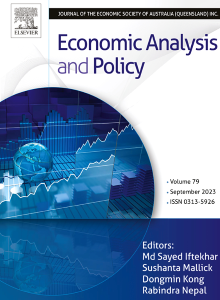The impact of community banks’ innovation on regulatory choices
IF 7.9
2区 经济学
Q1 ECONOMICS
引用次数: 0
Abstract
Launched in 2019, the Community Bank Leverage Ratio (CBLR) framework is a new regulation designed to reduce US community banks’ regulation burden. However, evidence has shown that only a minority of banks have voluntarily adopted this new regulation. Applying the Two-stage least squares-Instrumental variables method to analyze 4037 US community banks, we find out that the reduced likelihood of opting into the CBLR could be attributed to the insufficient bank innovation. Lack of innovation may reduce banks’ motivation to simplify reporting, reflect relatively few risky activities, and hold lower capital level, which prevents community banks from participating in this non-risk-based regulation framework. Moreover, compared to product innovation and process innovation, technological innovation has the most advanced impact on bank decision, and the influence is more pronounced in banks charted by federal authority. There also exists a bidirectional positive effect between the adoption of CBLR and bank innovation, where higher innovation level leads to higher CBLR adoption likelihood, and the CBLR adoption, in turn, accelerates the bank innovation and overall bank performance. Our findings remain robust across alternative variable measurements, estimation methods, model specifications, and various control variables.
社区银行创新对监管选择的影响
社区银行杠杆率(CBLR)框架于2019年启动,是一项旨在减轻美国社区银行监管负担的新法规。然而,有证据表明,只有少数银行自愿采用了这项新规定。运用两阶段最小二乘-工具变量方法对4037家美国社区银行进行分析,我们发现选择加入CBLR的可能性降低可能归因于银行创新不足。缺乏创新可能会降低银行简化报告的动机,反映相对较少的风险活动,并保持较低的资本水平,这阻碍了社区银行参与这种非基于风险的监管框架。此外,相较于产品创新和流程创新,技术创新对银行决策的影响最为超前,且在联邦权威机构绘制的银行中影响更为明显。采用CBLR与银行创新之间也存在双向的正向效应,创新水平越高,采用CBLR的可能性越高,采用CBLR反过来又加速了银行创新和银行整体绩效。我们的研究结果在可选变量测量、估计方法、模型规范和各种控制变量中都是稳健的。
本文章由计算机程序翻译,如有差异,请以英文原文为准。
求助全文
约1分钟内获得全文
求助全文
来源期刊

Economic Analysis and Policy
ECONOMICS-
CiteScore
9.80
自引率
9.20%
发文量
231
审稿时长
93 days
期刊介绍:
Economic Analysis and Policy (established 1970) publishes articles from all branches of economics with a particular focus on research, theoretical and applied, which has strong policy relevance. The journal also publishes survey articles and empirical replications on key policy issues. Authors are expected to highlight the main insights in a non-technical introduction and in the conclusion.
 求助内容:
求助内容: 应助结果提醒方式:
应助结果提醒方式:


